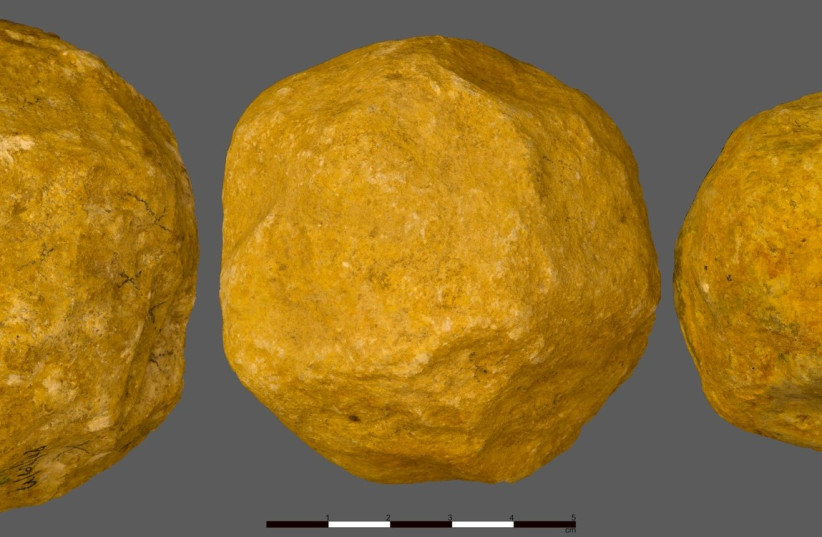An archaeological site in the Jordan Valley that experts at the Israel Antiquities Authority (IAA) call a “prehistoric Garden of Eden” was dedicated and opened to the public on Thursday.
At 1.6 million years, it is the oldest of its kind in Israel and one of the earliest outside of Africa. Saber-tooth tigers, giraffes, and huge, hairy mammoths walked in ‘Ubeidiya Park – an archaeological site of world-class importance for researching humans.
The ceremony took place in the presence of Jordan Valley Regional Council Head Idan Greenbaum, IAA Director Eli Escuzido, Israel Nature and Parks Authority General Manager Raya Shurky, Lake Kinneret Authority Chairman Moti Dotan, and Prof. Omry Barzilai, the representative excavator of the ‘Ubeidiya renewed archaeological mission.
Located next to Kibbutz Bet Zera, it was first identified in 1959 by Izzy Merimsky, a nature instructor and resident of the area.
Prof. Moshe Stekelis, Prof. Ofer Bar-Yosef, and Prof. Eitan Tchernov led a series of excavation expeditions. These missions revealed early hominin remains; flint, limestone, and basalt tools; evidence of many kinds of wildlife, including giraffes, jaguars, and hippopotami; and extinct species, such as mammoths and saber-tooth tigers.
The hominin who lived in ‘Ubeidiya belonged to the species known as Homo erectus.
A recently published study regarding a teen’s skeleton found in the Stekelis excavation provides a new understanding: The human migration out of Africa was not a one-time event but occurred in waves.

After the last excavation season in 1999, the site stood abandoned and exposed to the ravages of nature. Then, in 2021, site excavations were renewed in the context of a focused study by Prof. Barzilai on behalf of the Israel Antiquities Authority and the University of Haifa, together with Prof. Miriam Belmaker from the University of Tulsa in Oklahoma. In its wake, the site underwent conservation and development and is now accessible to the public.
2022: Ubeidiya is declared national park
In 2022, the Israel Nature and Parks Authority declared ‘Ubeidiya a national park. Simultaneously, the site was associated with the national project to rehabilitate and revive the Southern Jordan River Reserve in the Lower Jordan River’s northern segment, led by the Lake Kinneret Authority and the Jordan Valley Regional Council.
Coordinated efforts by the relevant bodies combined forces to implement the opening of the project to the general public.
Access roads were paved, as was a circular pedestrian route with explanatory signage. This is the first of three site development stages. In the next stage, the original excavation field laboratory will be opened as a visitor center.
Escuzido said, “This is a red-letter day for prehistory. ‘Ubeidiya is unique: This is a prehistoric site of inestimable scientific importance for researching the beginnings of the human race. Previous efforts to develop the site were unsuccessful due to the lack of appropriate partners to manage and maintain it. Today, turning ‘Ubeidiya into a national park as part of the greater Southern Jordan River Reserve promises a bright future.”
Shurky said that “the ‘Ubeidiya region is an exciting journey backward in time. The site contains three important areas that connect to one heritage story in the history of our land. First, ‘Ubeidiya’s prehistoric site represents man’s entry into the Middle East 1.5 million years ago.
Secondly, the adjacent Tell ‘Ubeidiya represents early Israel, which is based on the inscription of the Egyptian Pharoah Merneptah. Moshav Menahemia represents the beginning of the Zionist movement; established in 1901 right in this district and heralding Zionism flourishing throughout this region. These three sites tell the story and provide the complete picture of life in this region throughout the course of history until our own times.”
According to Zvika Sloutzky, the director of the Lake Kinneret Authority, “developing the northern part of the Lower Jordan River was declared to be a national project. This comes after it suffered many years of pollution and neglect since sewage was streamed here, and it was also used as an outlet for saltwater springs diverted from the north of the Kinneret.
The project’s purpose is to make this section of the river accessible to hundreds of thousands of visitors who visit this area while at the same time retaining its nature and character and transforming it into a swimming and recreational area. Many of the components are now completed.
The ‘Ubeidiya site lies on the western side of the lower Jordan River’s northern segment, while the river’s entire route has benefited from accelerated rehabilitation thanks to the Lake Kinneret Authority’s efforts here since 2012. Within this framework, restoration works were carried out on the prehistoric ‘Ubeidiya site, which has successfully turned it into an attractive and experiential visitor site for the general public.”
The site parallels the East African Olduvai Gorge sites, known as the “Cradle of Humanity,” said Profs. Barzilai and Belmaker.
“Ubeidiya has 30 geologic layers containing evidence of human activity during a time when there were many volcanic activities and the Syro-African Rift was widening and deepening,” Barzilai added.
Most of the layers are tilted since the area uplifted and became inclined due to later tectonic movements. This facilitates a journey through time, going back over one million years. “Excellent preservation of the site’s material finds enables recreating the Jordan Valley’s early ecological conditions,” say the scholars. “There is a unique broad selection of species to be found here, of which most are extinct and which includes African fauna side-by-side with European species.
The flint and stone tools at ‘Ubeidiya served its inhabitants to execute daily activities – butchering and cutting animal carcasses, processing vegetal foods, and more. These represent the Acheulian culture, including hand axes, scrapers, chopping tools, and spheroids and polyhedrons.”
